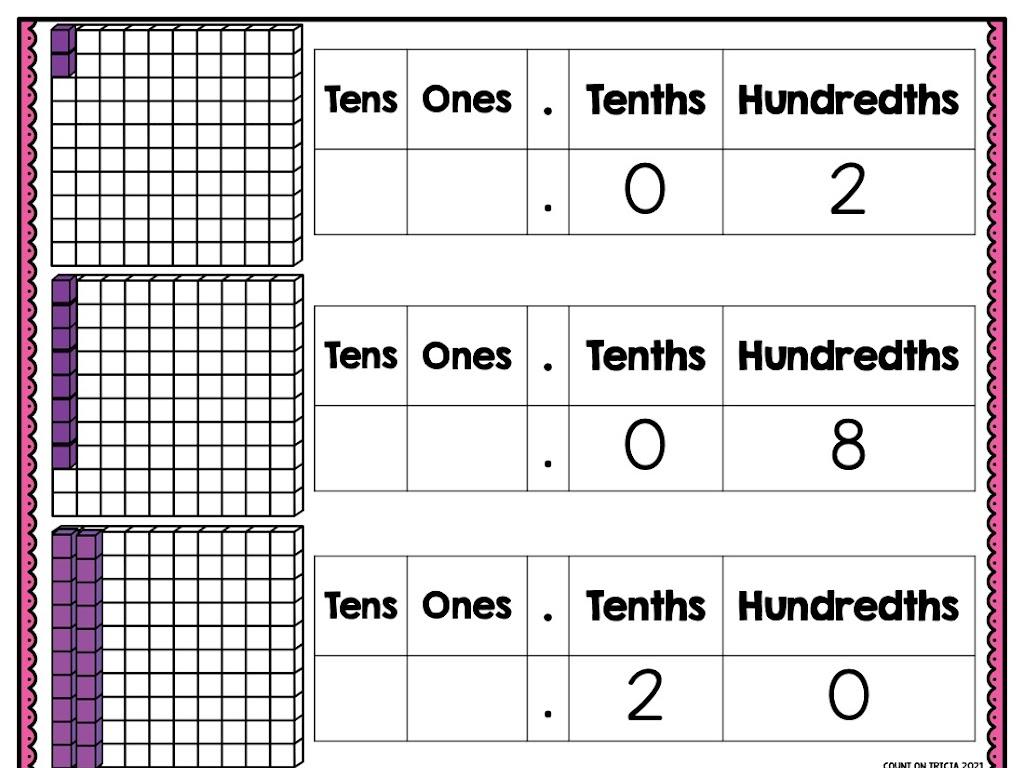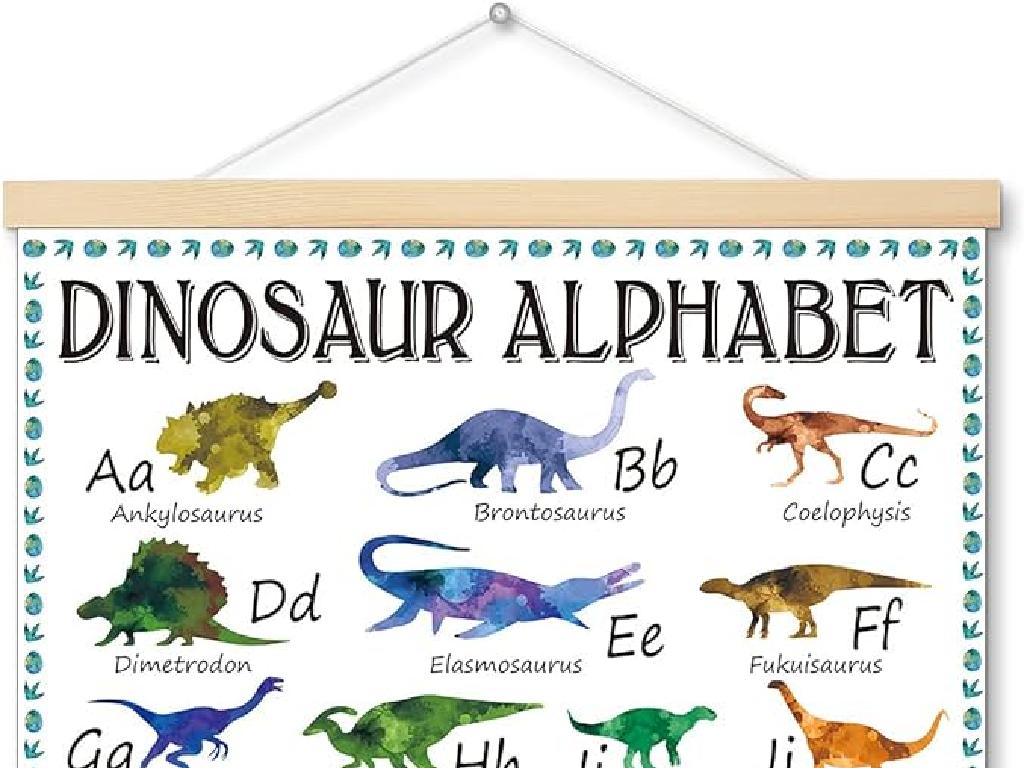Classify Rational Numbers
Subject: Math
Grade: Seventh grade
Topic: Rational Numbers
Please LOG IN to download the presentation. Access is available to registered users only.
View More Content
Welcome to Rational Numbers!
– Exploring rational numbers
– Defining rational numbers
– Numbers expressed as a fraction of two integers
– Examples of rational numbers
– 1/2, 3/4, and 5 (as 5/1) are all rational
– Recognizing non-examples
– Pi (À) and square root of 2 are not rational
|
This slide introduces the concept of rational numbers, which are any numbers that can be expressed as the quotient or fraction of two integers, where the denominator is not zero. It’s crucial to help students understand that all integers, finite decimals, and repeating decimals are rational because they can be represented as fractions. Provide clear examples such as 1/2 and 3/4, and also include whole numbers by showing that they can be written with a denominator of 1 (e.g., 5 as 5/1). Contrast these with non-examples like Pi (À) and the square root of 2, which cannot be expressed as a simple fraction of two integers. Encourage students to think of other examples and non-examples to solidify their understanding.
Classifying Rational Numbers
– Rational numbers as fractions
– A rational number can be expressed as a fraction a/b, where a and b are integers and b is not zero.
– Understanding numerator & denominator
– The top number, or numerator, represents parts we have, while the bottom number, or denominator, represents total parts.
– Whole numbers as rational numbers
– Every whole number can be expressed as a fraction with a denominator of 1, making it a rational number.
– Examples of rational numbers
– 3/4, 7/1 (which is 7), and 0/5 are all examples of rational numbers.
|
This slide introduces the concept of rational numbers to seventh-grade students. Begin by explaining that rational numbers include any number that can be expressed as a fraction, where the numerator and denominator are integers, and the denominator is not zero. Clarify the roles of the numerator and denominator in a fraction. Emphasize that all whole numbers are also rational because they can be written as a fraction with a denominator of 1 (e.g., 5 can be written as 5/1). Provide examples of rational numbers and encourage students to convert whole numbers and decimals into fractions to see them as rational numbers. This foundational understanding will be crucial for future topics in mathematics.
Classifying Rational Numbers
– Integers are rational numbers
– Any integer can be expressed as a fraction, e.g., 3 as 3/1
– Zero: A special rational number
– Zero is rational, can be written as 0/1
– Rational numbers as decimals
– Decimals that terminate or repeat are rational
– Practice identifying rational numbers
|
This slide introduces students to the concept that all integers are rational numbers because they can be represented as a fraction with a denominator of 1. Emphasize the unique nature of zero in this context, which can also be expressed as a fraction (0/1). Clarify that rational numbers in decimal form either terminate (like 0.5) or repeat (like 1/3 = 0.333…). Encourage students to practice by identifying whether given decimals are rational and converting them into fraction form. Provide examples and non-examples to solidify understanding.
Visualizing Rational Numbers
– Plot rational numbers on a line
– Place numbers on the number line based on their value.
– Compare and order rational numbers
– Determine which numbers are larger or smaller.
– Use rational numbers in real life
– Examples: money, measurements, and time.
– Understand rational number properties
|
This slide aims to help students visualize where rational numbers fall on a number line, which is crucial for understanding their value and relationship with other numbers. Students should learn how to compare and order these numbers, seeing which are larger or smaller. Additionally, providing real-life contexts, such as dealing with money, taking measurements, or telling time, can help solidify the concept of rational numbers. Emphasize that rational numbers include all integers, fractions, and decimals that can be expressed as a fraction of two integers. Encourage students to practice by plotting various rational numbers and comparing them to deepen their understanding.
Classifying Rational Numbers
– Natural, Whole, and Integers
– Natural (1,2,3…), Whole (0,1,2…), Integers (…-1,0,1…)
– Overlapping number categories
– Some numbers fit in multiple categories, e.g., 3 is natural, whole, and an integer
– Fractions as rational numbers
– Fractions with integer numerators and non-zero integer denominators
– Practice with classification
|
This slide introduces students to the concept of classifying rational numbers into different subsets: natural numbers, whole numbers, integers, and fractions. Emphasize that these categories can overlap; for example, all natural numbers are also whole numbers and integers. Highlight that fractions with integer numerators and non-zero integer denominators are also considered rational numbers. Provide practice problems for students to apply these concepts, such as classifying a list of numbers into the correct categories. This will help solidify their understanding of the number system and prepare them for more advanced mathematical concepts.
Rational Numbers in Everyday Life
– Money and rational numbers
– Every cent is a fraction of a dollar, e.g., $0.75 is 3/4 of a dollar.
– Measurements in daily tasks
– Cooking uses fractions: 1/2 tsp, 3/4 cup. Building requires precise measurements, often in fractions.
– Sports stats as rational numbers
– Batting averages like .300 or points per game are examples of rational numbers in sports.
– Understanding through examples
|
This slide aims to show students how rational numbers are not just theoretical concepts but are used in everyday life. Money is a perfect example, as it is often represented in decimals and fractions. Cooking and building are activities that require precise measurements, which are often expressed as fractions or decimals, making them rational numbers. Sports statistics are another relatable example where rational numbers are commonly used to represent data. Encourage students to think of other daily examples where they use rational numbers. This will help them understand the practicality and ubiquity of rational numbers in their lives.
Class Activity: Classifying Rational Numbers
– Group task: Classify a list of numbers
– Work in groups to categorize numbers into rational numbers
– Individual task: Find classroom rational numbers
– Look around the classroom for examples of rational numbers
– Share findings with the class
– Each student will present their classified numbers
– Discuss the classification process
– Reflect on the methods used for classifying numbers
|
This interactive class activity is designed to reinforce the concept of rational numbers through collaborative and individual tasks. Begin by dividing the class into small groups and provide each group with a list of various numbers. The groups will classify these numbers as rational or irrational. For the individual task, students will search the classroom for objects or quantities that can be expressed as rational numbers, such as the number of desks, windows, or tiles. Afterward, students will take turns presenting their findings to the class, fostering a discussion on how they determined the classification of each number. The teacher should guide the discussion, ensuring that students understand why a number is rational or irrational, based on its ability to be expressed as a fraction of integers. Prepare to offer examples and prompts to facilitate the activity and discussion.






